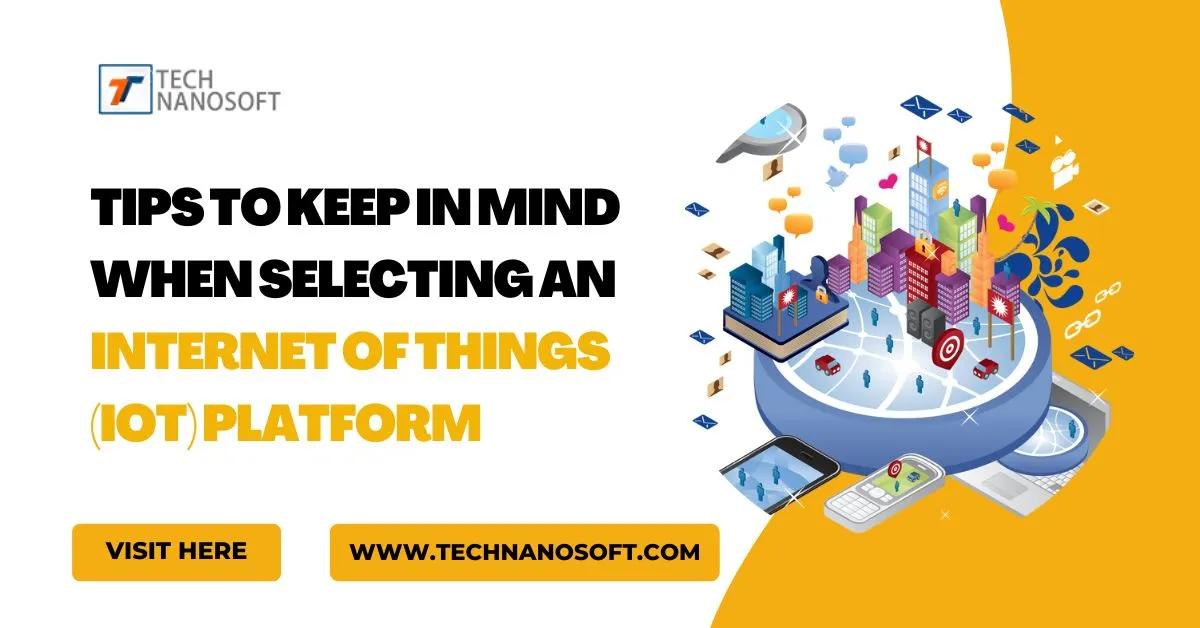Tips to Keep In Mind When Selecting an (Internet of Things) IoT Platform

The Internet of Things is becoming increasingly popular. Device producers and innovative services companies must understand how to manage an IoT platform. This is vital for success in the digital age. As a platform for your smart devices, you'll have to decide which is the best - whether it's a public cloud or private one, or on-premise - and set up everything from the application architecture and data structure to the security and troubleshooting: everything is essential, and you'll have to keep in mind the tips shared here to help you select the ideal IoT device management platform.
The Internet of Things (IoT) is one of the most exciting technologies that has come along recently. It promises to change the world as we know it, and it's already significantly impacting our lives.
However, while many talk about IoT, only some do anything about it. In fact, according to Gartner, only 1% of companies have implemented an IoT strategy, and only 6% have deployed an IoT application.
It is understandable since there are many things to consider when choosing which IoT device management platform you should use for your company. There are so many options; deciding on just one can be overwhelming if you need to know what you want.
What factors are required to consider while choosing platform in IoT?
That's why we're here to help! We've compiled a checklist of things you should remember when selecting your IoT management platform.
1. Is the platform secure?
The most important thing you can do when selecting an IoT platform is to ensure it's secure. Make sure the venue has strong encryption and authentication features—and make sure it has a team dedicated to keeping the system up-to-date with security patches and updates. If the company doesn't have a clear policy about handling data breaches or other vulnerabilities in its approach, run away as fast as possible!
2. Does the platform offer flexible pricing options?
It's significant to find an internet of things platform offering flexible pricing options, especially if you're starting or don't want to spend too much money on your new project. Look for platforms that offer "pay as you grow" plans so that you don't have to pay more than necessary at first and that if your business grows quickly and unexpectedly, you won't have any trouble upgrading later on.
3. How many devices do you need to monitor?
If you have thousands of devices, then a simple dashboard might not cut it for you. You may need software that gives you more control over individual devices and groups of devices at once so that you can react fast when something goes wrong with one or more of them.
4. Is the platform compatible with other essential applications and services to your business?
For example, suppose your company uses Slack or Salesforce, and those tools need to integrate better with the IoT. In that case, it might not be worth paying for that tool because it won't help your business achieve its goals as effectively as other options might work.
5. Some platforms are flexible and can be used for different purposes
If you're beginning with a few gadgets or sensors, you may opt for a flexible platform to develop with your changing needs. However, if you have a detailed plan and want to construct something reliable, think about a specialized platform with everything you need immediately, so you don't have to put in the effort to create extra features.
6. Check whether it is cloud-based or on-premise software
If you want to use the software for small numbers of devices and applications, then cloud-based software might be a better option for you because it doesn't require any hardware set-up or maintenance cost. However, suppose you want to manage thousands of devices across multiple sites. In that case, it's better to go for on-premise software as it offers flexibility in terms of scalability, customization, and security options.
In a world where everything is getting smart and connected to the internet, IoT is a massive part of the technological revolution. The Internet of Things is a network that manages physical devices, vehicles, home appliances, and other items embedded with electronics, software, sensors, and connectivity that allow such objects to collect and exchange that data.
How to Manage IoT Devices And How It Works??
IoT monitoring platforms are a new way of connecting to the internet. They allow you to manage your IoT devices more quickly and efficiently. Here's how they work:
Such a platform manages all your connected devices through one interface. In real time, you can monitor what's happening with each device on your screen or mobile app. You can also control each device individually or as a group based on certain conditions like time or location.
You can use it for many purposes, such as collecting data from machines in your factory or monitoring security cameras at your business location. You can even use it for personal tasks like keeping track of your health data with fitness trackers like Fitbit or Apple Watch!
The Internet of Things (IoT) is a network of physical objects. These objects embedded with electronics, software and sensors that can connect and exchange data through the internet. With over 6 billion connected devices in the world today, IoT continues to grow exponentially. The number of connected devices will exceed 50 billion by 2020 — IDC predicts that the market will be worth $7.1 trillion by 2025.
This management is software solutions that help companies build, manage and secure their IoT ecosystems. Choosing an option in the market can take time and effort for businesses beginning their journey into IoT. There are many choices available today.
Also Read: IoT Privacy And Security Challenges & Solutions – How to Keep Your Data Safe









